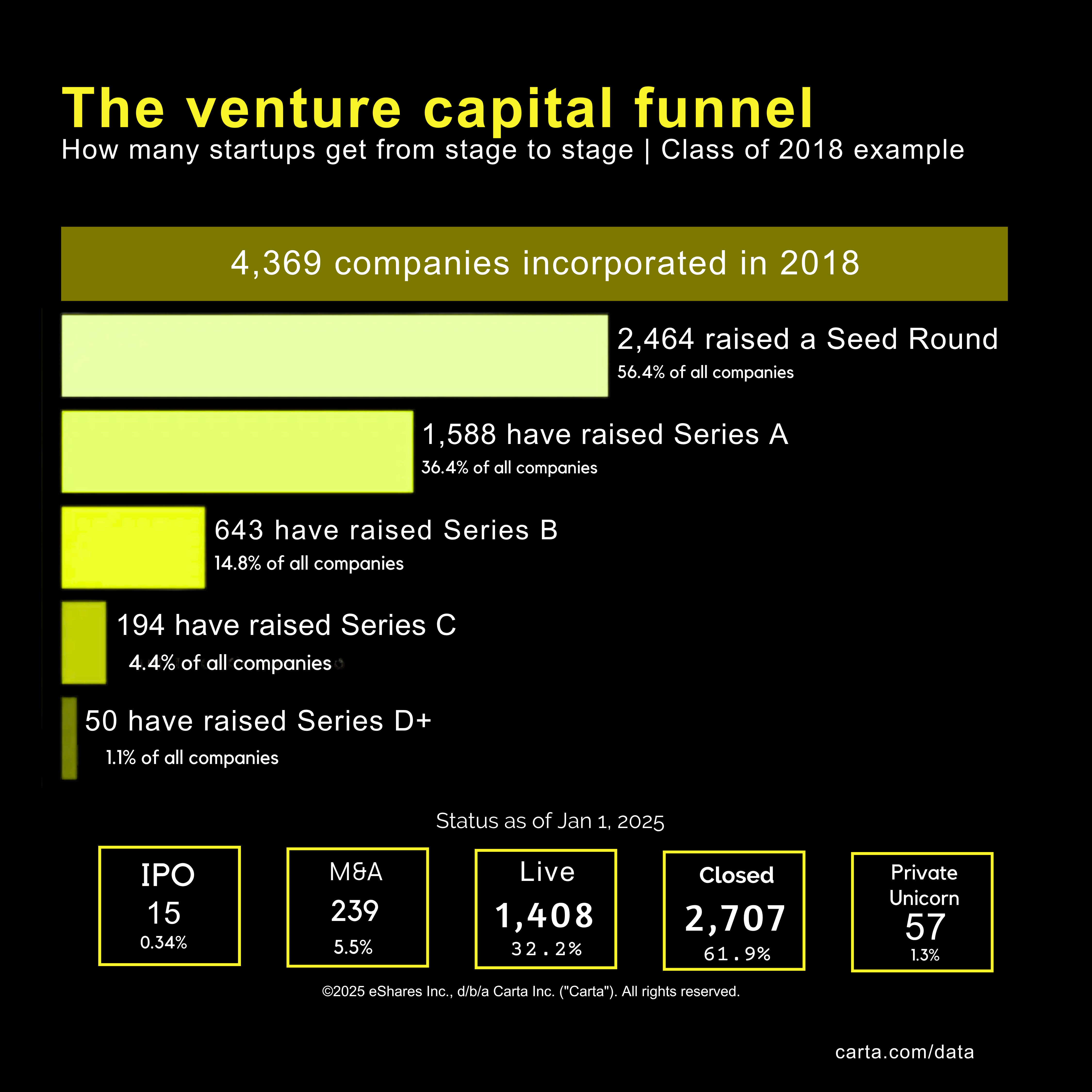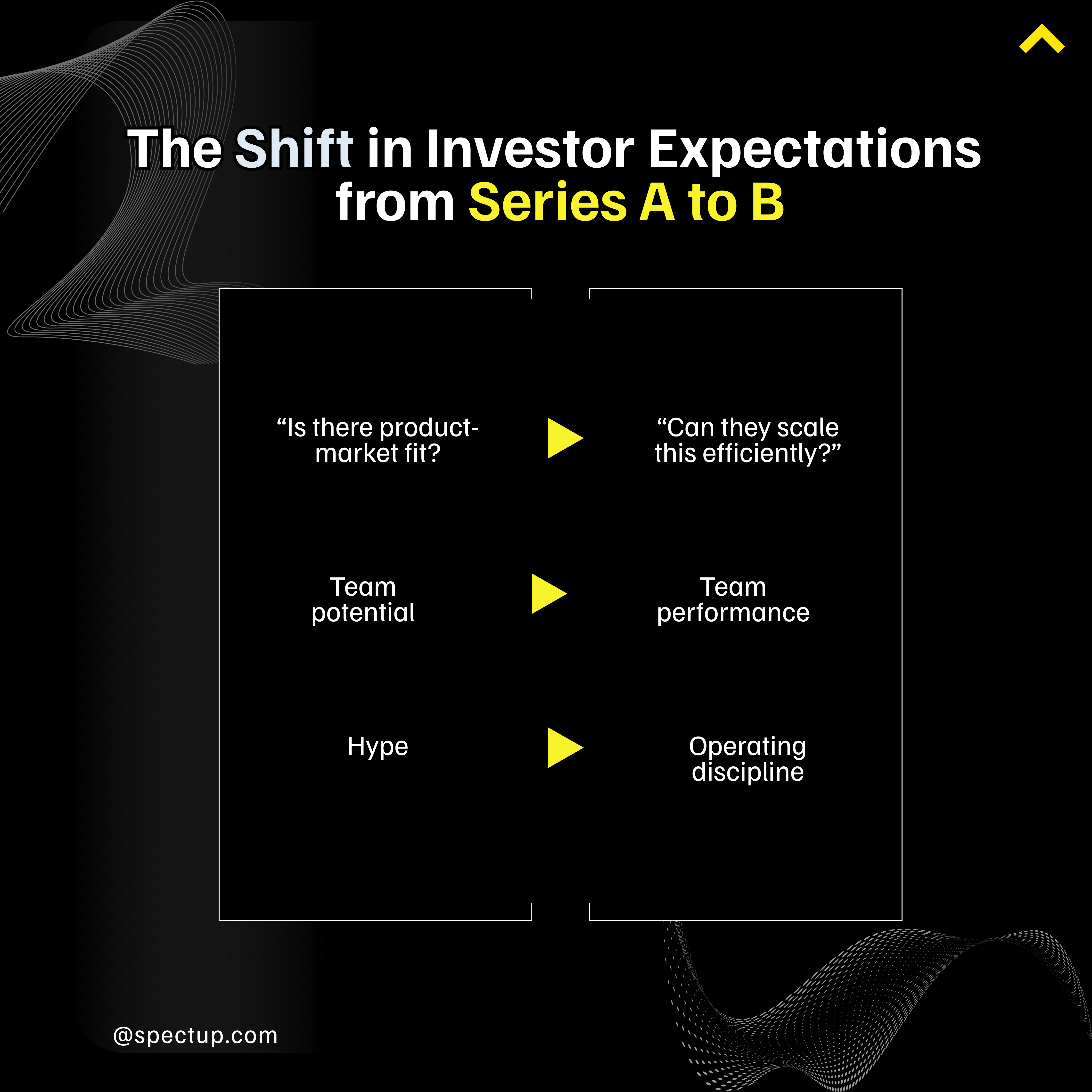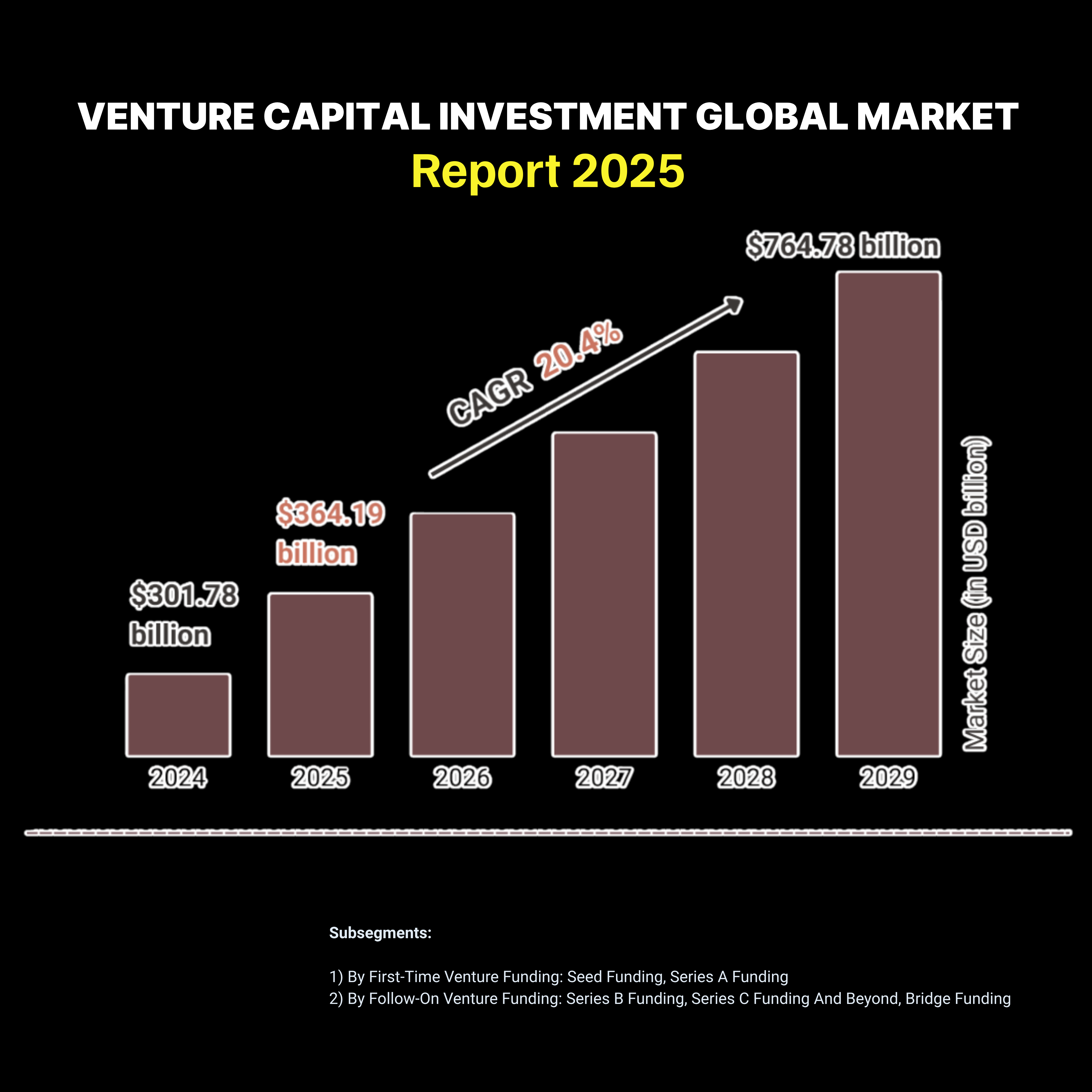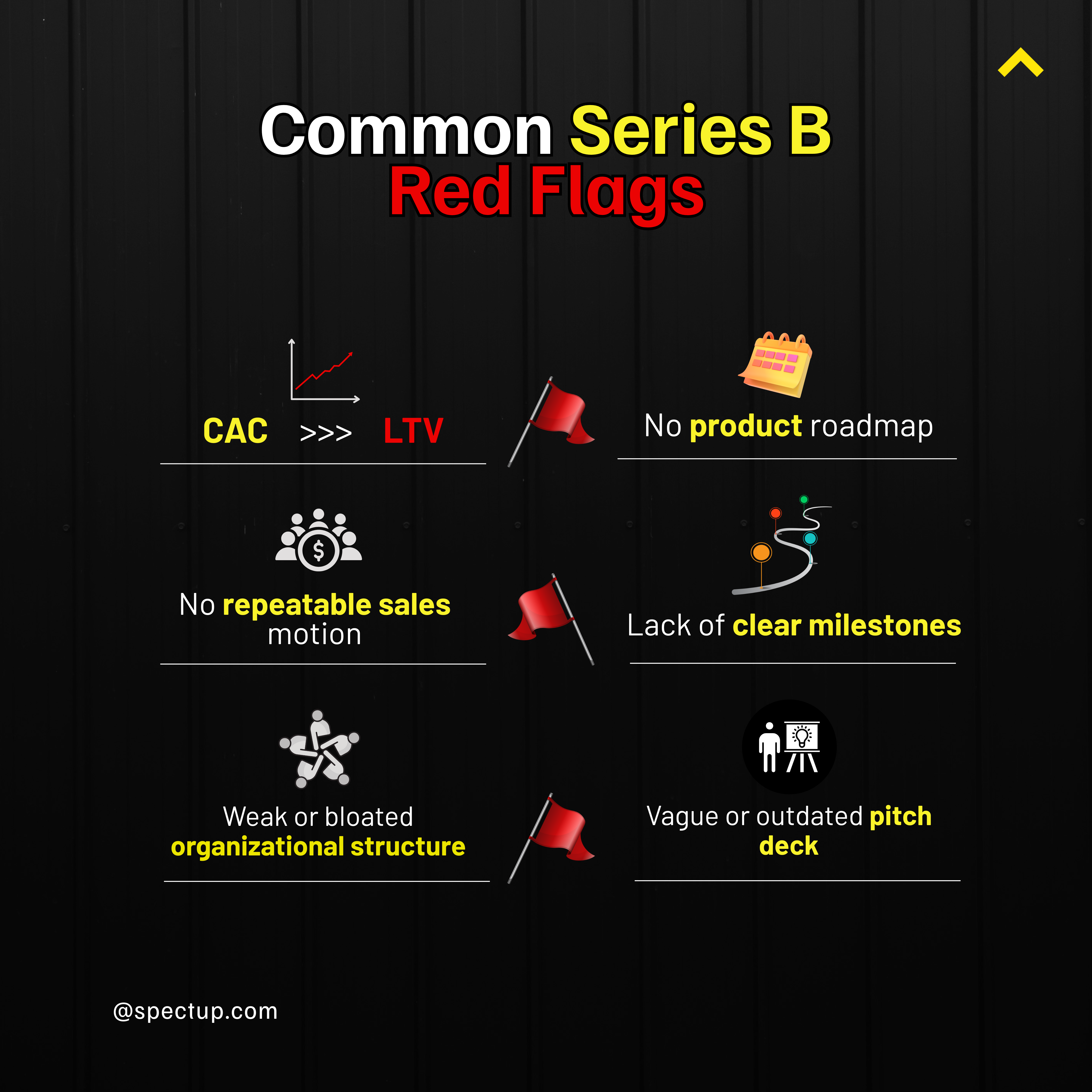How Growth-Stage Startups Nail Their Series B Without Burning Out

Startup Ecosystem Shift in 2025
In 2025, the startup ecosystem witnessed a remarkable and unexpected transformation. Startups specializing in AI and fintech are experiencing rapid growth and acceleration. These companies are attracting substantial investments from venture capitalists and showing exceptional resilience in the face of economic challenges. Their ability to adapt quickly to market demands is positioning them as industry leaders in the ever-evolving tech landscape.
Starting a business is like going on an exciting roller coaster ride, with each funding round adding unexpected twists and turns to the journey. However, reaching Series B is nothing less than a wild context. According to CodeVentures, the chance of failure drops to 1% for the startups that can make it past Series B.
As growth-stage startups prepare for their Series B funding, the stakes are higher than ever. This important milestone can propel a company to new heights or leave it struggling to survive. The challenges these startups face at this stage are huge - from managing rapid growth to ensuring long-term sustainability. Finding the right balance between aggressive expansion and stable operations becomes crucial to avoid burning out too soon.
In this ever-changing environment, mastering the art of balancing scaling and maintaining resilience is the key to successfully navigating Series B without succumbing to the pressures of growth.
Understanding What Series B Investors Actually Want
Series B investor expectations shift significantly from earlier rounds. At this stage, investors are hunting for clear signs that your startup isn’t just a flash in the pan but a well-oiled machine ready to scale.
Key startup growth metrics they focus on include:
- Traction: Not just a one-time spike but consistent quarter-over-quarter revenue growth that signals stability and momentum.
- Revenue growth: Demonstrating that your business model is not only working but accelerating.
- Unit economics: Solid CAC (Customer Acquisition Cost) to LTV (Lifetime Value) ratios prove your go-to-market (GTM) strategy is profitable and scalable.
The average Series B investment hovers around $30 million, reflecting the increased confidence and expectations investors place on startups at this stage.

What Your Series B Signals Should Communicate?
Your Series B pitch should clearly communicate the following:
- A scalable GTM model backed by healthy CAC:LTV metrics.
- A clear roadmap for expansion—whether that’s new markets, additional products, or ramped-up headcount.
- Organizational maturity across operations, leadership, finance, and hiring processes.
Investors want to see less “potential” and more proven execution. The spotlight moves from the excitement of discovery toward reliable systems and disciplined growth strategies. That’s your green light to show how you’re managing complexity without losing speed—crucial if you want to ace how to raise Series B.

Here are some statistics to help understand the percentage of startups that progress from Seed funding to Series B.
- Even in the best of times, it is rare for a company to go from Seed to Series A and then from Series A to Series B in 4 years (according to the typical VC assumption).
- Only about 22% of such companies were able to achieve this during the boom years, and now it's less than 10%. This analysis assumes that all these companies were trying to secure a Series B round. This assumption may not be entirely accurate for more recent cohorts, but not by much.
- Mergers and acquisitions (M&A) play a minor role in this process. It is estimated that around 5-6% of the initial Seed cohort will have been acquired before reaching the Series B round.
- Most Seed investments won't enter the growth stages of venture capital for several years, if at all. Many of the "best" Seed investments will take time to develop. Most Seed investors are humble enough to acknowledge that the biggest successes in their portfolios are not usually the most obvious ones.
Venture capital is a long-term game. Six years after the Seed round, 20%-23% of companies have reached the Series B stage and there is still much more to accomplish beyond that point where only 55% of companies have been acquired before reaching the Series B round, highlighting the resilience and growth potential of startups that continue to progress through the venture capital stages.

Preparing Your Startup for Series B Success:
Preparing for Series B funding requires tremendous effort and precision. It's more likely that strategizing, aligning and anticipating the answers to the questions that might arise during the pitching is the pivotal point that determines whether the potential candidate is either eligible for the funding or not. That is called the Aura, that defines where exactly the founder and investor see the startup in upcoming 6-10 years. Here are some key aspects that determine the Series B success:
- Organize Your Data Room: Building an organized data room with legal documents, cap tables, and pitch decks is crucial. This preparation streamlines due diligence and instills confidence in investors.
- Align Your Team Structure: Aligning team structure and leadership roles to support scaling ensures a smooth transition into the growth phase. Clear delineation of responsibilities prevents bottlenecks and empowers efficient decision-making.
- Anticipate Investor Questions: Anticipating investor due diligence questions and requirements demonstrates foresight and professionalism. Addressing potential concerns proactively can mitigate risks and build trust.
- Study Venture Market Funnel and Research the trends: Understanding the current trends and dynamics of the venture market funnel helps in positioning your startup and aligning your growth strategy accordingly. Analyzing successful Series B startups in your industry can provide valuable insights and benchmarks.
- Focus on Metrics: Series B investors often prioritize metrics such as revenue growth, customer acquisition cost (CAC), lifetime value (LTV), and gross margin. Tracking and optimizing these metrics will help showcase your startup's financial health and growth potential.
The size of the venture capital investment market has grown significantly in recent years. It is projected to increase from $301.78 billion in 2024 to $364.19 billion in 2025, with a compound annual growth rate (CAGR) of 20.7%. The growth during this period can be attributed to factors such as:
- The expansion of the entrepreneurial ecosystem
- Market trends and industry changes
- Government policies and incentives
- Investor confidence and risk appetite
- The emergence of new sectors and technologies

Avoid Common Pitfalls
Common pitfalls founders face in the run-up to Series B include burnout symptoms in growth-stage startups:
- Founders still involved in every major decision can hamper scalability and hinder delegation.
- A stretched-thin team across scaling initiatives leads to inefficiencies and reduced productivity.
- Constant urgency, missed deadlines, and reactive hiring indicate operational weaknesses that require attention.
- A disconnect between strategy and execution results in misaligned efforts and suboptimal outcomes.
Address Tactical Challenges
Tactical pitfalls that undermine fundraising efforts include inconsistent revenue forecasting, headcount outpacing organizational maturity, sloppy financials or delayed audits, and unclear expansion plans lacking strategic depth. These challenges must be addressed proactively to ensure a successful Series B round.
The Series B Readiness Checklist:
Nailing your Series B means ticking off a solid Series B readiness checklist that covers every angle from documents to operations.
Key Documents & Materials
- Financial models with multiple scenarios reflecting different growth paths and risks
- A clear, data-backed go-to-market strategy showing how you’ll scale efficiently
- Polished product demos that wow investors and prove customer validation beyond words
Internal Alignment on Milestones and KPIs
Make sure your team is on the same page about where you are and where you’re headed. This means:
- Forecasting revenue and margin by product, channel, and geography with confidence
- Having a documented hiring plan that ties headcount directly to business outcomes
- Understanding churn inside out — why customers leave and how you fix it
- Confirming post-sale operations can handle a big jump in volume without hiccups
Ops Readiness & Visibility
Dashboards should give you real-time insights into:
- Sales velocity and pipeline health — no surprises here
- Onboarding success rates and customer satisfaction metrics
- Finance team delivering timely monthly reports that keep numbers transparent
- Headcount planning synced tightly with revenue targets and support needs
This checklist doesn’t just prepare you for investor questions — it keeps your startup sharp, scalable, and sustainable on the path to Series B success.
Crafting a Compelling Series B Pitch Deck and Narrative:
Your Series B pitch deck isn’t just a slideshow—it's your startup’s story on steroids. Investors crave clarity, confidence, and proof that you’re ready to scale big without tripping up. Nail these core elements in your narrative:
- Market opportunity size: Show where you stand today and the playground you’ll own three years down the line. Numbers matter, but so does vision.
- Why now? What’s the trigger unlocking growth post-Series B? Maybe it’s tech maturation, regulatory shifts, or new customer behaviors fueling demand.
- Expansion lever: Be specific—whether it’s diving into a new segment, expanding geographically, or launching a killer product line.
- Organizational improvements: Highlight leadership upgrades, streamlined ops, or revamped finance systems since your last round.

Beware of pitfalls that kill momentum:
- Treating Series B like a safety net instead of fuel for growth scares investors off.
- Using vague phrases like “grow the team” or “build product” without substance feels like filler.
- Failing to connect current traction to future upside leaves your story hanging in midair.
Support your storytelling with rock-solid materials:
- A board-approved plan with clear milestones ensures everyone’s on the same page.
- KPI scorecards demonstrate disciplined tracking of what truly moves the needle.
- Use-of-funds slide directly linked to execution goals proves you know exactly how investment turns into outcomes.
This approach turns your pitch deck from “just another presentation” into a persuasive roadmap investors can’t wait to back.
Developing a Robust Financial Model for Growth Stage Startups:
As a growth-stage startup, you are likely preparing for your Series B round of funding. One of the key components that investors will scrutinize during this process is your financial model. A well-developed financial model not only helps you understand the financial health of your business but also serves as a powerful tool to communicate your growth potential to investors.
As per recent stats, cash flow problems and financial issues account for 16% of startup failures.
Key Financial Levers to Model:
When building your financial model, it is crucial to identify and forecast the key financial levers that drive your business. These levers will vary depending on your industry and business model, but here are some common ones to consider:
- Customer Acquisition Cost (CAC) and Payback Period by Channel: Understanding how much it costs to acquire a customer and how long it takes to recoup that cost is vital for assessing the efficiency of your marketing and sales efforts.
- Gross Margin by Product or Service Line: Analyzing the profitability of each product or service offering will help you make informed decisions about pricing, cost management, and resource allocation.
- Churn and Retention (Logo + Revenue): Keeping track of customer churn rates and retention metrics is essential for predicting future revenue growth and identifying areas for improvement in customer satisfaction.
Headcount and Payroll Forecast Tied to Go-To-Market (GTM) and Operations Capacity: As your business grows, so does the need for additional talent. Forecasting headcount and payroll expenses in alignment with your GTM strategy and operational capacity will ensure that you have the right resources in place to support growth.

Must-Have Model Scenarios:
To account for uncertainties and potential risks, it is important to include different scenarios in your financial model. Here are some must-have scenarios to consider:
- Base Case Scenario: This represents your most likely outcome based on current assumptions and projections.
- Stretch Case Scenario: This scenario outlines an optimistic view of growth where key metrics outperform expectations.
- Downside Case Scenario: Here, you analyze the impact of adverse events or challenges that could hinder growth.
- Runway Simulation with and without Series B Round: Understanding how long your current funding will last (runway) under different scenarios can help you plan ahead for fundraising needs.
- Cost of Delay Analysis: Assessing what happens if you raise funds later than planned can provide insights into potential opportunity costs.
Tools and Teams:
Building a robust financial model requires collaboration between various stakeholders within your organization. Here are some tools and teams that can assist you in this process:
- Fractional CFO or Finance Partner: Working with an experienced finance professional can bring valuable expertise to your modeling efforts.
- Layered Financial Models with Clearly Defined Assumptions: Breaking down complex models into layers makes it easier to understand dependencies and test different scenarios.
- Integration of CRM and Finance Data: Connecting customer relationship management (CRM) systems with finance data allows for more accurate forecasting by incorporating actual sales performance into projections.
By leveraging these resources, you can enhance the quality of your financial model while also ensuring alignment across teams involved in its creation.
Creating a robust Series B financial model is an iterative process that should begin early when preparing for Series B funding. It should be viewed as a living document that evolves alongside your business. Developing a comprehensive financial model tailored specifically for growth-stage startups is crucial when preparing for Series B funding. By focusing on key financial levers such as CAC, gross margin, churn rates, headcount forecasts etc., including multiple scenarios like base/stretch/downside cases; runway simulations; cost-of-delay analyses; working with experts like fractional CFOs/finance partners; using layered models/integrating CRM-finance data - you'll be better equipped to navigate investor discussions confidently!
Scaling Leadership Teams Without Burning Out: Strategies for Founders in Growth Stage Startups
Building a scaling leadership team is like assembling the Avengers of your startup—each role must be clear, powerful, and ready to take on the chaos without losing their cool. Investors at Series B expect you to have key roles filled with seasoned pros who can drive growth while keeping operations smooth and sustainable.
Key Roles Investors Expect by Series B:
- VP or Head of Sales: Owns revenue targets and sales execution with scalable processes.
- Marketing or Growth Lead: Drives channel strategies with measurable ROI.
- Experienced Head of Finance or Fractional CFO: Manages financial discipline and forecasting rigor.
- Customer Success or Implementation Lead: Ensures retention and smooth onboarding for growing customer bases.
A Management Operating System is non-negotiable. Weekly leadership meetings anchored by KPI dashboards keep everyone honest about progress. Clear role definitions and decision rights cut through confusion. Regular performance reviews tied to compensation benchmarks ensure accountability. Founders must evolve from day-to-day firefighting into strategic oversight—because wearing every hat leads straight to burnout.

- Define clear outcomes and onboarding plans before hiring.
- Prioritize cultural and operational fit over shiny resumes.
You want a leadership team that scales not only the business but also emotional resilience—a critical ingredient for nailing your Series B without burning out.
Pre-Nurture Your Series B Investor Funnel
Build a List 3–6 Months in Advance
- Segment your list by fund size, check size, geography, and sector focus.
- Utilize resources like Crunchbase and PitchBook, along with warm referrals, to identify potential investors.
- Give priority to Series A investors who may have passed on your opportunity but still expressed interest.
Send Pre-Raise Updates
- Send monthly or quarterly investor updates to warm prospects.
- Include key performance indicators (KPIs), product releases, new hires, and strategic shifts in your updates.
- Encourage potential investors to ask soft diligence questions before the formal process begins.
Prepare Your Materials Early
- Create a refined pitch deck that includes your investor narrative and detailed plan for how you will use the funds.
- Develop a financial model that clearly outlines your assumptions and includes separate tabs for different aspects of your business.
- Set up a data room with essential documents such as your cap table, organizational chart, key contracts, and historical financial statements.
This aligns with the strategies outlined in the guide to startup fundraising, which can provide further insights into preparing for successful fundraising.
Identifying and Avoiding Common Series B Red Flags:
Investors have sharp eyes for Series B red flags those warning signs that suggest your startup might struggle to scale or manage growth sustainably. Spotting these pitfalls early in your startup expansion strategy can save you from a fundraising nightmare.
Watch out for:
- CAC rising faster than LTV: If your Customer Acquisition Cost climbs while Lifetime Value stagnates or drops, alarm bells should ring. It means you're spending more to get customers than they’re worth, a killer for scaling efficiently.
- No repeatable sales motion: Relying on the founder’s charisma or lucky breaks with certain channels isn’t sustainable. Investors want to see a predictable, repeatable process that drives consistent revenue growth.
- Weak or bloated organizational structure: Too lean and you risk burnout; too bloated and you waste precious runway. A messy org chart signals poor operational discipline and can spook investors who want evidence of scalable leadership.
- No product roadmap discipline or velocity: Moving fast without direction is just chaos. Lack of clear milestones or slow progress on product development raises questions about your ability to innovate and stay ahead in the market.
- Vague or outdated pitch deck: If your deck doesn’t clearly communicate current momentum, market opportunities, and how you’ll deploy new funds, it feels like you’re stuck in the past—hardly inspiring confidence.

Avoid these traps to keep your Series B story compelling and investor-ready.
Conclusion: Fundraising Shouldn’t Come at the Cost of Focus:
Nailing your Series B means preparing for due diligence well before the term sheet hits your inbox. Think of it as setting your startup up for investor readiness, not just scrambling to pass legal and financial checks.
Here’s the secret sauce:
- Prepare thorough documentation ahead of time — organized cap tables, updated financial models, clean contracts
- Coordinate cross-functional teams so questions from investors get lightning-fast answers
- Keep your focus sharp on growth execution rather than firefighting fundraising chaos
Burnout is real when founders juggle scaling and fundraising without clear processes. You want to build momentum, not roadblocks. When you handle investor demands with calm efficiency, you show discipline and maturity—exactly what Series B backers crave.
How Growth-Stage Startups Nail Their Series B Without Burning Out? It boils down to being ready in every sense: operationally, financially, and mentally. Get those ducks in a row early, and the journey becomes smoother and way more enjoyable.
Contact spectup and let us help you raise, while you focus on the story and the journey.
Series B investors look for consistent quarter-over-quarter revenue growth, a scalable go-to-market model with solid CAC:LTV economics, a clear roadmap for expansion across markets, products, and headcount, and organizational maturity in operations, leadership, finance, and hiring
Startups should build an organized data room with legal documents and pitch decks, align team structures to support scaling, anticipate investor due diligence questions, maintain consistent revenue forecasting and pipeline health, avoid reactive hiring, and ensure internal alignment on milestones and KPIs to balance aggressive growth with sustainable operations.
Founders should avoid burnout symptoms such as being involved in every decision or stretching the team too thin. Tactical pitfalls include inconsistent revenue forecasting, headcount outpacing organizational maturity, sloppy financials or delayed audits, and having an unclear or generic expansion plan that lacks strategic differentiation.
A strong Series B pitch deck should cover market opportunity size (current and projected), a clear 'why now' rationale unlocking post-Series B growth, specific expansion levers like segments or geographies, organizational improvements since the last round, a board-approved plan with milestones, KPI scorecards, and a use-of-funds slide clearly tied to execution goals.
How can startups develop robust financial models suitable for Series B fundraising?
Founders should build a management operating system featuring weekly leadership meetings with KPI dashboards, clear role definitions and decision rights, regular performance reviews with compensation benchmarks. It's important to avoid 'hire panic' by defining outcomes before hiring senior roles prioritized by cultural fit over brand names. Founders must transition from firefighting to strategic oversight to maintain operational sustainability and emotional resilience.
Concise Recap: Key Insights

Ready to Take the Next Step?
Whether you're a startup looking for funding or an investor seeking prime opportunities, we're here to help.
Contact Us

